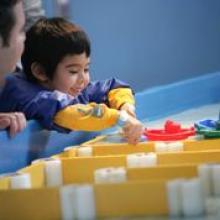
Children’s museums are not traditional museums with exhibits of ancient artifacts scaled down for children. They are interactive places designed specifically for children where they learn through play and exploration. Children discover and gain understanding through a myriad of experiences in a hands-on environment based on their own interests and pace.1 As a family-friendly environment, “children play to learn and adults learn to play.”2
The children’s museum movement began with the opening of the first children’s museum in Brooklyn, New York, in 1899. Within the next twenty years new children’s museums were established at the Smithsonian in Washington, DC, and in Detroit, Boston, and Indianapolis. The desire to improve the lives of children in the late 1800s, particularly in urban settings, produced the child-saving movement, which spawned the children’s museum movement, the play and playground movement, an organized camping movement, a school gardens movement, and a nature movement.3
The early children’s museums were influenced by the popular theories in education advocated by John Dewey and Maria Montessori, who believed that children learned more effectively through personal experiences rather than the traditional lectures and rote memorization. Guiding children to think on their own and handle materials led to better understanding of subjects taught in the classroom.4
In the 1950s there was a renewed interest in children’s museums from the followers of Jean Piaget, who believed that children learned by interacting with their world and the objects in it. But the modern children’s museum was born in the early 1960s from the new direction the Boston Children’s Museum was taking under the leadership of Michael Spock. He developed more interactive exhibits for children, such as City Slice, which was a three-story house and basement that was cut away to expose the construction details, and Grandparents house, where they could dress up in grandma’s clothes and use old-fashioned gadgets in the kitchen.5
Michael Spock changed the concept for the children’s museum to be client centered catering to children’s needs at their various age levels and developmental stages. He was the first to design exhibits for children under the age of five, allowing babies and toddlers to explore in their own environments. Children became the focus in the design process for the museum. Exhibits were built taking into consideration the height and scale needed for the children who would be interacting in them. The exhibits were more sturdily built and designed with the children’s motor skills and ability to read considered. Client-centered exhibits were also designed to use all the senses and allowed open-ended play, where the children could enter or exit the exhibits at any point and still make sense of them.6
Another pioneer in children’s museums was Frank Oppenheimer, who opened the Exploratorium in San Francisco in 1969. As a physics professor, he had developed a “library of experiments” that allowed students to explore scientific principles at their own pace, following their own curiosity. Using this model, children in his museum were given the opportunity to discover scientific phenomena on their own and gain confidence in their ability to understand science and the world. This model greatly influenced the development of more participatory exhibits in other children’s museums.7
As the children’s museum movement grew, the directors of the museums joined together to form what is now the Association of Children’s Museums (ACM). As of 2007, there were over 340 museum members representing 22 countries with many more in the developmental stage. The largest children’s museum is The Children’s Museum of Indianapolis, with a total of 433,000 square feet of space.8 The second largest children’s museum is The Strong in Rochester, New York, which houses the National Museum of Play, the International Center for the History of Electronic Games, and the National Toy Hall of Fame.9
- 1. “Why visit a children’s museum?” Association of Children’s Museums. < http://www.childrensmuseums.org/visit/why_visit.htm > 29 June 2011.
- 2. “Children’s Museum History.” Children’s Museum of Central Nebraska. < http://www.cmocn.org/history.htm > 29 June 2011.
- 3. Frost, Joe L. A History of Children’s Play and Play Environments. New York, NY: Routledge. 2010. pp. 75-78.
- 4. McDougall, Kim. “Children’s Museums: A History and Profile.” Transcript of lecture given in 1999 by Kim McDougall, Director, Canadian Children’s Museum, Quebec, Canada.
- 5. Ibid/
- 6. Ibid.
- 7. “Our Story.” Exploratorium. < http://www.exploratorium.edu/about/our_story/ > 30 June 2011.
- 8. “Stats and Trends.” Association of Children’s Museums. < http://www.childrensmuseums.org/about/facts.htm > 29 June 2011.
- 9. “History.” The Strong. < http://www.thestrong.org/about-us/history > 30 June 2011.

